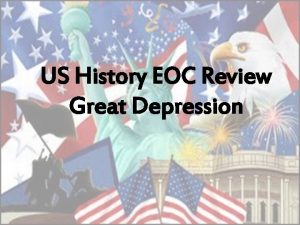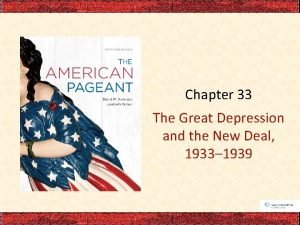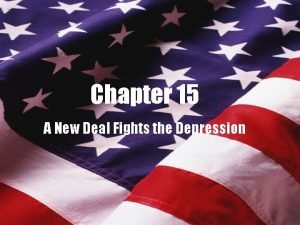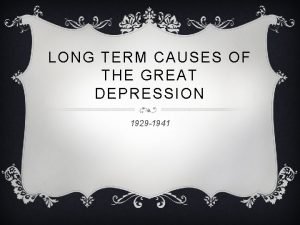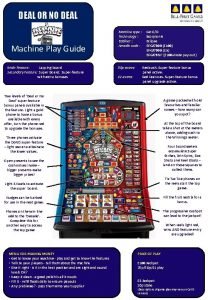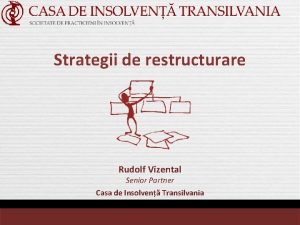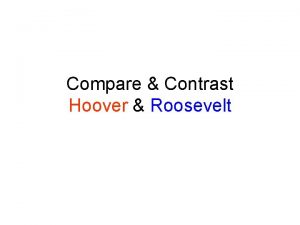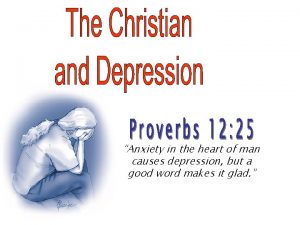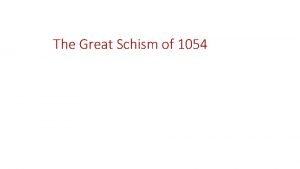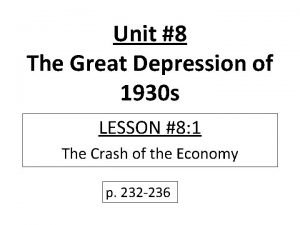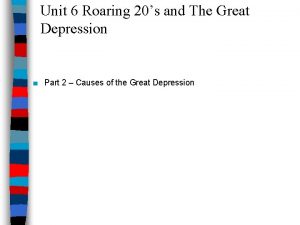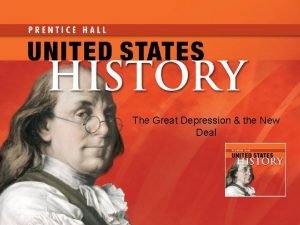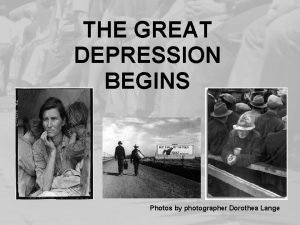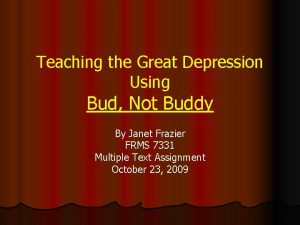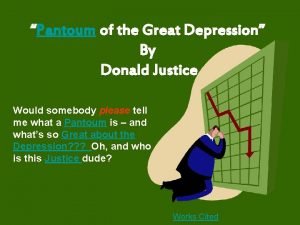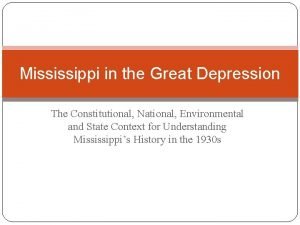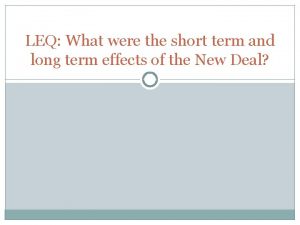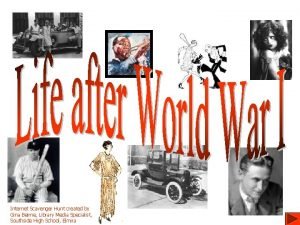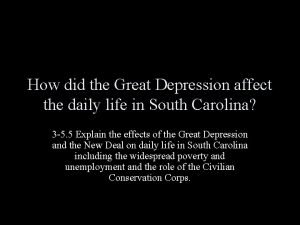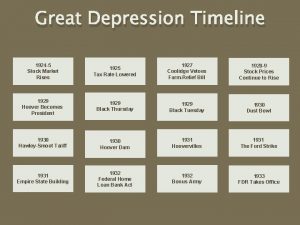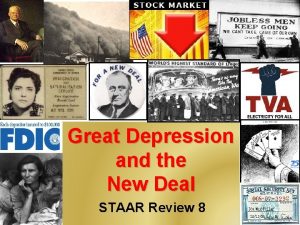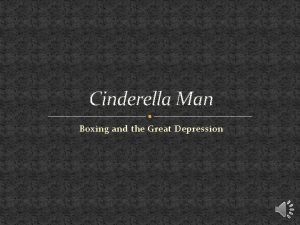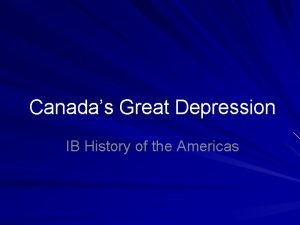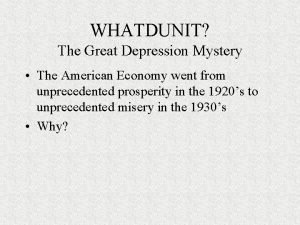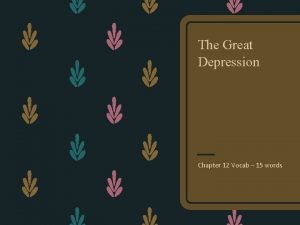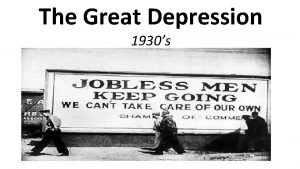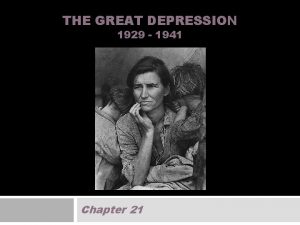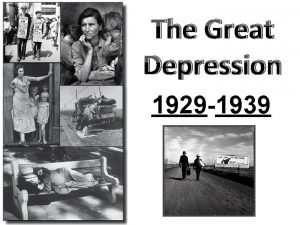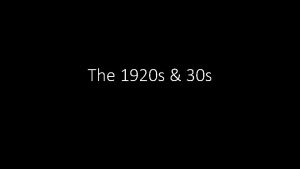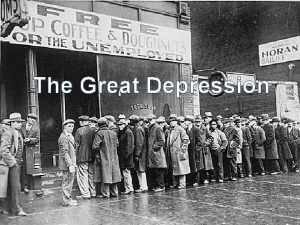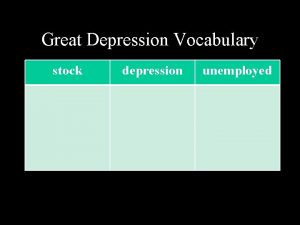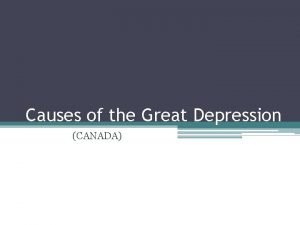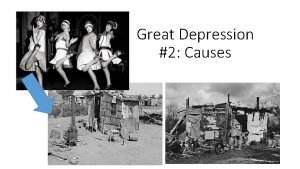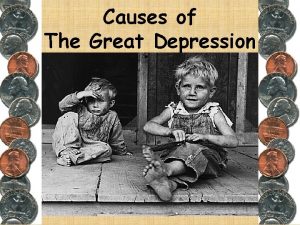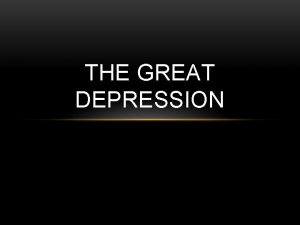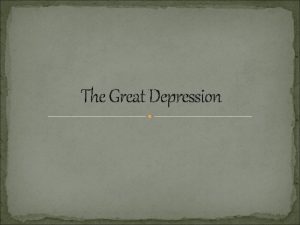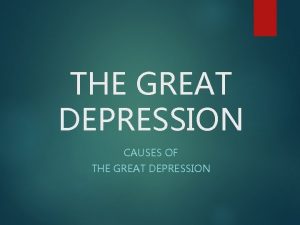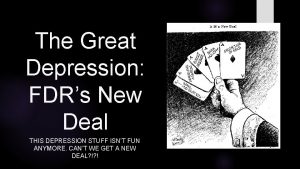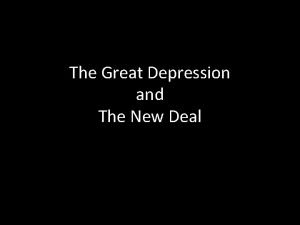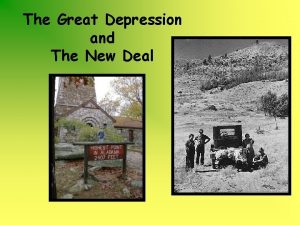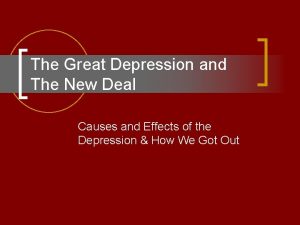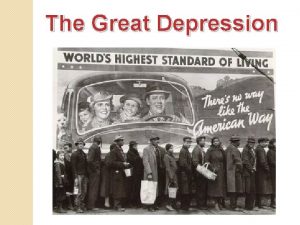The Great Depression and New Deal Fundamental Causes













































- Slides: 45

The Great Depression and New Deal

Fundamental Causes of the Depression • Drop in farm prices • Massively uneven distribution of income • “Get rich quick” schemes in real estate and especially in stocks • Overextension of credit • Increased inventories of goods • Immediate cause: October 1929 stock market crash Many consumers in the 1920 s bought items such as this ironer on credit

The Day the Bubble Burst • October 29, 1929 • More than 16 million shares traded in one day • Stock market lost $30 billion • Beginning of the “Great Depression” The trading floor of the New York Stock Exchange in 1929

Banking System Collapse • Banks invested heavily in the market • Collapse of market led to bank failures • Many depositors panicked, leading to even more bank failures Worried depositors wait outside a bank hoping to withdraw their savings

Hoover’s Response • President Hooverwhelmed • Believed that private charity was best suited to solve problems • Most efforts failed • Reconstruction Finance Corporation achieved some success President Herbert Hoover

Hoovervilles • Settlements of shacks inhabited by transients and unemployed • Derisively named after President Hoover • Many cities and towns had at least one

The Bonus Army With the U. S. capitol visible in the distance, shacks erected by the Bonus Expeditionary Force burn • Patman Bill was to move up bonus payments from 1945 to 1933 • Veterans camped near the Capitol to support the bill • Bill failed in Congress • Hoover’s removal of vets made Hoover appear heartless

The Election of 1932 Hoover • Republicans renominated Hoover • Democrats nominated Franklin D. Roosevelt • Hoover’s inability to solve the Depression became the chief issue • FDR won in a landslide Roosevelt

Franklin Delano Roosevelt • Born in 1882 • Distant relative of Theodore Roosevelt • Married to Eleanor Roosevelt, TR’s niece • Political career mirrored TR’s • Lost 1920 election for vice president • Paralyzed in 1921 One of only three photos of FDR in a wheelchair, taken in 1941

FDR’s First Inaugural Address • Attempted to restore confidence in the American people • “The only thing we have to fear is fear itself. ” • Asked for broad executive powers to combat the Depression FDR and Herbert Hoover on the way to the inauguration

The “New Deal” FDR campaigning in 1932 • Named after a phrase in FDR’s 1932 nomination speech • Became the nickname for FDR’s economic program • Consisted of three separate aspects: • Relief • Recovery • Reform

The First Hundred Days • Three-month period after inauguration • Flurry of legislative activity • “Honeymoon” period between FDR and Congress • Saw most of New Deal’s relief program established, including: • Agricultural Adjustment Act • Tennessee Valley Authority • Glass-Steagall Banking Act FDR signing the TVA into law

Solving the Banking Crisis • 1930– 1933: Nearly 10, 000 banks closed • Michigan governor ordered banking “moratorium” in state • FDR changed wording to bank “holiday” • Banks closed for four days for inspection • Glass-Steagall Act created FDIC A policeman stands guard outside a closed New York bank

Fireside Chats FDR addresses the nation during a 1935 fireside chat • Radio “talks” • FDR spoke plainly with audience about issues and concerns • Usually conducted in an informal manner • FDR gave 30 chats while in office

FDR’s Farm Program • Agricultural Adjustment Act of 1933 sought to reduce farm surpluses • Resettlement Administration • Farm Security Administration • Rural Electrification Administration • Agricultural Adjustment Act of 1936 A poster advertises help to farmers available through the Resettlement Administration

The Dust Bowl: Causes • Overcultivation of land in the Great Plains • Sustained drought throughout region • High winds blew away loose A dust cloud approaches the town of Stratford, Texas, in 1935 topsoil

The Dust Bowl: Impact • More than 500, 000 left homeless • Storms blew large amounts of dust from the Plains into cities such as Chicago and Buffalo • “Red snow” fell on towns in New England

The Plight of the “Okies” • Farmers from Oklahoma fled the Dust Bowl • Went to California for farm jobs • Possibly 15 percent of Oklahoma’s population became migrants A woman and her child rest beside their car during their trip west

Hardships • “Camps” unsanitary • Wages decreased for large numbers • California passed an “anti-Okie” law A migrant camp in California

The “Migrant Mother” • One of the most famous New Deal–era photos • Shot for the Resettlement Administration by Dorothea Lange • Taken in California in February or March 1936

Work-Based Relief Programs A New Deal work-based relief program at a Florida rock quarry • FDR considered unemployment a major, immediate problem • Work-based programs seen as a desirable alternative to the dole • Several programs were created to provide work in various occupations • Some saw the “make work” programs as boondoggles

Civilian Conservation Corps • Provided jobs for young men aged 18– 25 • Jobs included work on environmental projects • One of the most popular New Deal programs • “Enlistees” were paid $30 per month, with $25 of that sent home to their families

Public Works Administration • Money given to contractors for public works • Administered by Secretary Ickes • Built bridges, schools, airports, roads, Navy ships • Spent more than $6 billion

Civil Works Administration CWA-built public works projects included this Minnesota highway • Mainly constructed bridges and buildings • Spent over $1 billion in less than a year • Many considered it a boondoggle • Abandoned in 1934

Works Progress Administration • Created in 1935 • Headed by Harry Hopkins • Focused on public works such as bridges, roads, runways • Also included arts projects • Some projects famous (Camp David, Dealey Plaza) Signs similar to this one alerted the public that a site was a WPA works project

In addition to public works projects, the WPA also provided adults with job training as well as enrichment opportunities

The “Nine Old Men” • Supreme Court dominated by conservatives • FDR unable to make appointments to Court • Court declared several New Deal programs unconstitutional • FDR believed that the Court was hampering needed relief and reform

FDR’s “Court-Packing” Plan • FDR determined to preserve New Deal reforms • Introduced legislation for revamping the judiciary • Law would allow him to appoint one new judge for every Supreme Court member over age 70½ • Would increase Supreme Court to a maximum of 15 members • Plan soundly defeated; FDR lost political support • Court-packing battle ended as a draw

The American Liberty League • Saw FDR as a “traitor to his class” • Believed the New Deal was leading the country toward socialism • Several famous members • Challenged the legality of the Wagner Act • Disappeared by 1940

FDR’s Second Inaugural Address “I see millions of families trying to live on incomes so meager that the pall of family disaster hangs over them day by day. I see millions whose daily lives in city and on farm continue under conditions labeled indecent by a so-called polite society half a century ago. I see millions denied education, recreation, and the opportunity to better their lot and the lot of their children. I see one-third of a nation, ill-clad, illhoused, ill-nourished…” Franklin D. Roosevelt January 20, 1937 The cover of the program for FDR and Vice President Garner’s inauguration

New Deal Reform Measures • Sought to ensure that conditions leading to Depression did not reoccur • Many reforms radically changed American society • Several New Deal programs and reforms still in effect today • Social Security • Pure food and drug laws • Tennessee Valley Authority • FDIC

Social Security Act of 1935 • First suggested by Frances Perkins • Provided for • Old-age pensions • Unemployment insurance • Aid to dependents • Funded by a payroll tax

National Labor Relations Act • Also known as the “Wagner Act” • Allowed for collective bargaining • Protected rights of laborers to form unions • Also created the NLRB FDR signs the Wagner Act as Labor Secretary Perkins looks on

Fair Labor Standards Act • Guaranteed a federal minimum wage • Set at 25 cents per hour in 1938 • Guaranteed overtime pay at “time and a half” • Prohibited “oppressive child labor” The FLSA prohibited children (such as the one shown in this photo) from working in hazardous jobs

Tennessee Valley Authority • • Created to assist Tennessee Valley area Headed by David Lilienthal Provided flood control and cheap hydroelectric power Also protected the social and economic welfare of people in the area

Help for Homeowners • Home Owners Loan Corporation: lowinterest loans for current homeowners • Federal Housing Authority: loans for home repair and new building projects • United States Housing Authority: low-cost public housing Federal Housing Authority logo

Securities and Exchange Commission • Created through Securities Act of 1933 and Securities Exchange Act of 1934 • Laws required truth in sales of securities and fair treatment of investors • SEC’s purpose to provide market stability and protect investors Joseph P. Kennedy, the first head of the SEC

Creation of the “Welfare State” FDR signing the Social Security Act into law • New Deal signaled the beginning of the “welfare state” • Government became the overseer of citizens’ welfare from “cradle to grave” • Many New Deal reform programs still greatly affect American life • Some see the costs and level of government involvement as drawbacks

FDR and Civil Rights • Significant debate regarding FDR’s civil rights record • Refused to support anti-lynching law • Did not work to integrate armed forces • FEPC ensured equal opportunity for African Americans in government and defense-industry jobs • Appointed African Americans to government positions Ralph Bunche

Popular Culture in the New Deal Era • Music of Woody Guthrie • Novels of John Steinbeck (The Grapes of Wrath) • 1930 s movies • Humorist Will Rogers • Radio’s impact on American life (The War of the Worlds) A 1930 s-era movie theater

Woody Guthrie • Folk singer • Wrote “This Land Is Your Land” and other songs about Depression-era life • Inspired several 1960 s folk singers • Died in 1967

John Steinbeck • Known for his novels about California • The Grapes of Wrath describes the Joad family’s travels from Oklahoma to California • Praised and criticized by many • Novel won Pulitzer Prize; soon made into a film

Will Rogers • American humorist • Radio and movie star and newspaper columnist • Satirized politics and current events • Killed in 1935 plane crash

The End of the New Deal • A recession and jump in unemployment raised concerns about the New Deal • Several New Deal agencies continued into the early 1940 s • Full employment and the end of the Depression only occurred with U. S. involvement in World War II Workers assemble a military aircraft

The Legacy of the New Deal • Enlargement of government • Deficit spending • Welfare state • Inspiration for future welfare programs, such as LBJ’s “Great Society” FDR shakes hands with Texas NYA director—and future president—Lyndon Johnson
 Vocabulary review causes of the depression
Vocabulary review causes of the depression What is the main idea of this cartoon?
What is the main idea of this cartoon? Chapter 33 the great depression and the new deal
Chapter 33 the great depression and the new deal A new deal fights the depression
A new deal fights the depression Chapter 15 section 1 a new deal fights the depression
Chapter 15 section 1 a new deal fights the depression Great depression causes
Great depression causes What were the long term causes of the great depression
What were the long term causes of the great depression A great deal vs a great many
A great deal vs a great many Deal or no deal machine
Deal or no deal machine Asset deal vs share deal
Asset deal vs share deal Compare and contrast hoover and fdr
Compare and contrast hoover and fdr Anxiety in the heart of man causes depression
Anxiety in the heart of man causes depression The great depression lesson 2 hardship and suffering
The great depression lesson 2 hardship and suffering Pros and cons of the great depression
Pros and cons of the great depression Dust bowl migration map
Dust bowl migration map Benjamin west contribute a great deal to american art
Benjamin west contribute a great deal to american art What was the deal breaker in the great schism
What was the deal breaker in the great schism Rarig great depression
Rarig great depression Great depression
Great depression The ingenious quarterback political cartoon
The ingenious quarterback political cartoon Foreclosure great depression
Foreclosure great depression Five effects of the great depression
Five effects of the great depression Five effects of the great depression
Five effects of the great depression How did the great depression impact the world
How did the great depression impact the world Mein kampf definition ap world history
Mein kampf definition ap world history Bud not buddy
Bud not buddy Pantoum of the great depression analysis
Pantoum of the great depression analysis Summary of great depression
Summary of great depression Cpi during the great depression
Cpi during the great depression Okies great depression
Okies great depression The great depression leq
The great depression leq Five effects of the great depression
Five effects of the great depression How did the great depression affect daily life
How did the great depression affect daily life What caused the dust bowl
What caused the dust bowl Brief summary of the great depression
Brief summary of the great depression Boxing during the great depression
Boxing during the great depression Birth rate during the great depression
Birth rate during the great depression Overspeculation great depression
Overspeculation great depression Great depression vocab
Great depression vocab Great depression vocabulary
Great depression vocabulary Great depression
Great depression Http://www.history.com/topics/great-depression
Http://www.history.com/topics/great-depression Great depression 1929
Great depression 1929 Hawley-smoot tariff great depression
Hawley-smoot tariff great depression Stock market crash 1929 political cartoon
Stock market crash 1929 political cartoon Lesson 3 effects of the great depression
Lesson 3 effects of the great depression

